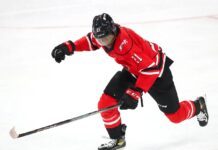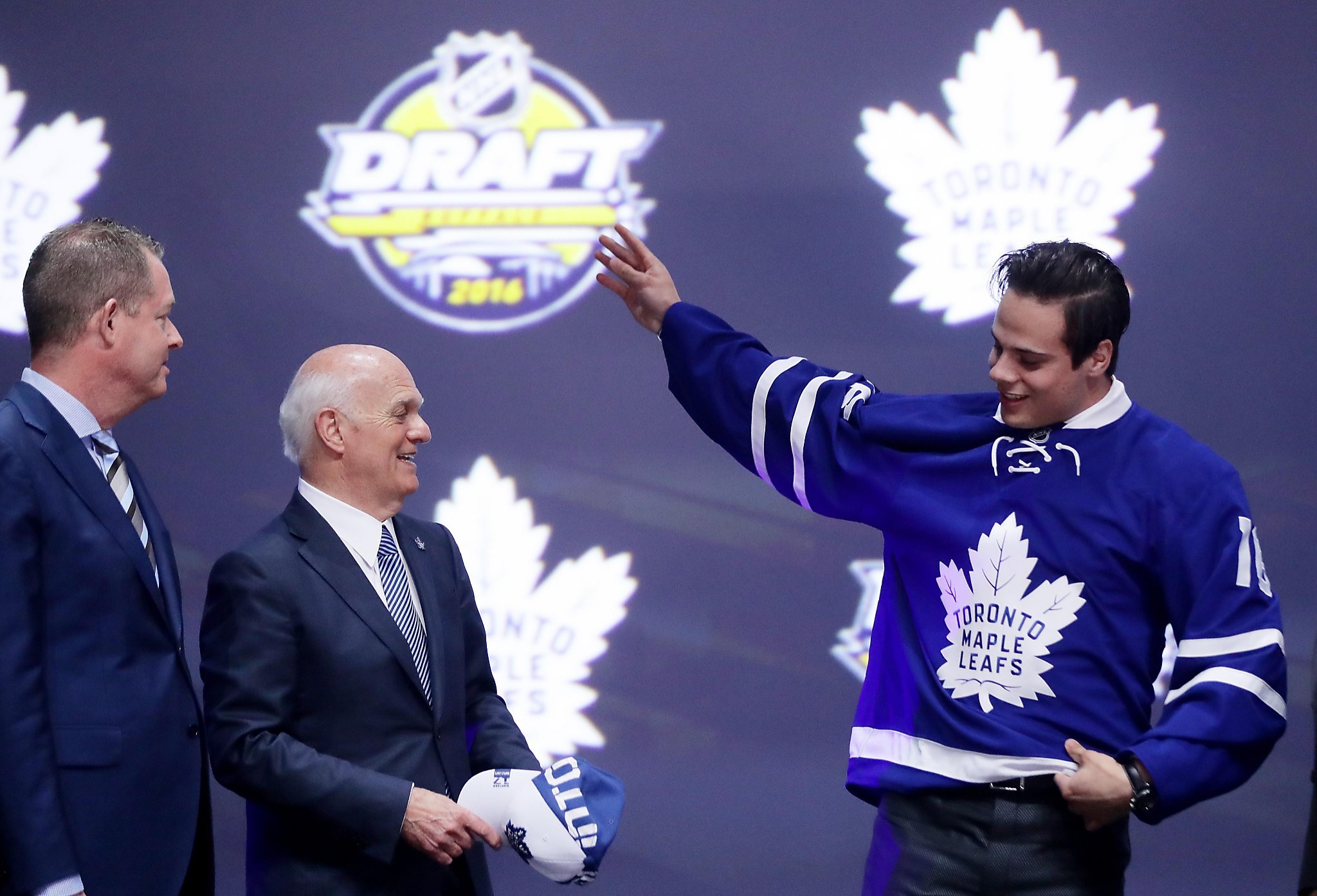The Toronto Maple Leafs have formally introduced the Auston Matthews era after Mark Hunter made the first-overall pick official at the 2016 NHL Draft podium in Buffalo.
So ends any Patrik Laine or trade-down paranoia and so begins a night of celebration and new jersey buying for Leafs Nation. The list of surefire centers the organization has drafted with potential of this calibre is a short one. Over the 47-year history of the NHL draft, you have to go back to Vincent Damphousse at sixth overall in 1986 and Darryl Sittler eighth overall in the 1970 amateur draft.
Finally, the Leafs land a potentially elite number-one center
It goes without saying that the addition of an elite center can transform an NHL franchise.
Among Hart Trophy skater winners since 1980 (removing goalies), a centerman won the Most Valuable Player award 23 times out of 32. The one Cup-winning team since the 2004-05 lockout without a centerman that met most people’s definition of “elite” was Andy McDonald on the 2006-07 Anaheim Ducks, but he was a point-per-game player that season in Anaheim, and the Ducks had the depth of a young Ryan Getzlaf and veteran shutdown center Samuel Pahlsson behind him as well as the best defence duos in recent NHL history in Scott Neidermayer and Chris Pronger.
Stanley Cup Winning Teams by Number One Center Since 2005-06
| Season | Top Center | Season PPG | Playoffs PPG |
|---|---|---|---|
| 2006 | Eric Staal | 1.2 | 1.12 |
| 2007 | Andy McDonald | 0.95 | 0.67 |
| 2008 | Pavel Datsyuk | 1.18 | 1.05 |
| 2009 | Sidney Crosby | 1.34 | 1.29 |
| 2010 | Jonathan Toews | 0.87 | 1.32 |
| 2011 | Patrice Bergeron | 0.71 | 0.87 |
| 2012 | Anze Kopitar | 0.93 | 1.0 |
| 2013 | Jonathan Toews | 1.02 | 0.61 |
| 2014 | Anze Kopitar | 0.85 | 1.0 |
| 2015 | Jonathan Toews | 0.81 | 0.91 |
| 2016 | Sidney Crosby | 1.06 | 0.79 |
The Toronto Maple Leafs have been without a high-end number one center since Mats Sundin left in 2008. Incidentally, the Leafs haven’t won a playoff round since Sundin’s Leafs lost out in the conference semifinals in 2004. Post-Mats, the Leafs have made a total of one conference quarterfinals appearance, following a shortened season in which the team rode hot goaltending, and it ended in complete disaster.
Even if you point to the occasions when the Blackhawks or Kings or Bruins won without their top center breaking into point-per-game territory (an increasingly difficult feat in today’s NHL), a team cannot survive in the most gruelling playoffs in professional sports without a center who has the elite ability to dictate the game in all three zones for 20+ minutes a night against the best players in the league while putting up significant offensive production.
The game is so quick today that there’s as much responsibilities put on the centermen as being put on the defensemen. As much as we want our defensemen to jump into the play, we want our centermen to be the first forward back.
– Bob Hartley
In Auston Matthews, the Leafs have drafted a player with all the tools — the size, the skill, the shot, the skating, the competitiveness, the hockey sense and intelligence — needed to become one of the league’s premiere two-way players at the most crucial skater position on the roster. 19 years old by the start of next season and with a year of overseas professional experience under his belt, Matthews will be coming off an appearance for Team North America at the 2016 World Cup of Hockey and will be ready to make an impact this Fall.
Leafs fans have been impatiently waiting for a true first-line center just as long as they’ve been waiting for a playoff victory for a reason. Finally, the timing, the luck and the strategic managerial tanking planning came together all at once to deliver the Toronto Maple Leafs their best prospect in the modern era and the centerpiece of the most promising core of young players in recent franchise history.
Auston Matthews Scouting Report
Courtesy of the 2016 NHL Draft Black Book
Auston Matthews made the decision to take an unusual path and play his draft season in Switzerland. The move to Zurich was a success even if the end was disappointing, as the #1 seed ZSC was swept in the 1st round by eventual NLA champions SC Bern. Throughout the season Matthews proved to be ready to compete against men on a regular basis and posted the best goal per game ratio in the league, while developing his two-way game under Marc Crawford’s guidance. He was not able to convert his chances in his four playoff games, but his finishing ability is not in question. His play at the World Championships in May only confirmed he is ready to be an impact player in the NHL as soon as he steps in next fall.
Matthews is a smooth and powerful skater, without the puck in the offensive zone he keeps his feet moving, making himself a moving target that the defense struggles to keep track of. Especially if paired with players who can play and think an up-tempo game, defenders struggle to catch him, as he quickly combines with linemates and jumps on opportunities. In those circumstances he seems consistently one step ahead of the play, makes snap decisions time after time and he has no problems executing quickly. He can change gears and directions while he reads the play, shares the puck and makes himself available in high-scoring areas.
Matthews has tremendous puck skills but doesn’t need to have the puck on his stick a lot to be effective and dangerous offensively, which bodes well for his transition to the NHL. He is the complete package offensively, has the skills to beat defenseman one on one, the vision to set up linemates and a dangerous shot that takes very little time (or space for that matter) to get off. He has good size, doesn’t play a big physical game but he uses his size along the boards and is very effective on the cycle. A favourite move of his is bouncing the puck against the boards (or even the base of the net) to turn and escape the defender while keeping possession. He likes to be around the net and is a big threat down low.
He can still remain effective when slowing down the game, relying on his playmaking ability. He’s committed to playing a sound defensive game and is a very complete and versatile player. He is a high-end talent who already plays a mature game as a 18 year old, it’s difficult to find flaws in his skillset.
In most of our viewings he has not been able to play with maximum intensity throughout the whole game and usually showed less jump through the second leg of back to back games, but that’s nitpicking considering it’s not always been the case. It’s not a big stretch to say an 18 year old will improve his endurance.
Surefire star two-way centers rarely come around. You seldom find prospects that project to the next level as safely as this kid does.
Auston Matthews Statistics
| SEASON | TEAM | LEAGUE | GP | G | A | TP | PIM | +/- |
|---|---|---|---|---|---|---|---|---|
| 2012-13 | Arizona Bobcats 16U | Midget | 48 | 55 | 45 | 100 | 16 | |
| 2013-14 | USNTDP Juniors | USHL | 20 | 10 | 10 | 20 | 4 | -5 |
| U.S. National U17 Team | USDP | 24 | 12 | 21 | 33 | 10 | ||
| U.S. National U18 Team | USDP | 20 | 12 | 5 | 17 | 8 | ||
| USA U17 | WHC-17 | 6 | 4 | 4 | 8 | 8 | ||
| USA U18 | WJC-18 | 7 | 5 | 2 | 7 | 4 | 7 | |
| 2014-15 | USNTDP Juniors | USHL | 24 | 20 | 28 | 48 | 10 | 20 |
| U.S. National U18 Team A | USDP | 60 | 55 | 61 | 116 | 30 | ||
| USA U18 A | WJC-18 | 7 | 8 | 7 | 15 | 0 | 11 | |
| USA U20 | WJC-20 | 5 | 1 | 2 | 3 | 4 | 0 | |
| 2015-16 | ZSC Lions | NLA | 36 | 24 | 22 | 46 | 6 | 16 |
| USA U20 A | WJC-20 | 7 | 7 | 4 | 11 | 2 | 6 | |
| USA | WC | 10 | 6 | 3 | 9 | 2 | 0 |

































